The Oregon Queer History Collective, formerly known as the Gay & Lesbian Archives of the Pacific Northwest, was founded in October 1994 by a small group of community historians in Portland. At the time, it was the only gay and lesbian organization of its kind in the Pacific Northwest, with the stated purpose of “advancing the visibility of queer cultural history within the Pacific Northwest.” From the beginning, GLAPN partnered with the Oregon Historical Society to house and add to a collection of LBGTQ materials. It was an unusual arrangement, particularly at a time when most gay and lesbian historical organizations struggled to gain respect. OQHC has been an official affiliate of the Oregon Historical Society since 2013; the collection has grown to over 150 cubic feet.
For gays and lesbians in Oregon, the 1990s were marked by struggles for equal rights in housing and employment and against the Oregon Citizens Alliance’s anti-gay ballot measures. In the summer of 1994, Allan Bérubé, the author of Coming Out Under Fire: The History of Gay Men and Women in World War II, gave a seminar at Portland State University where he emphasized the importance of organizing efforts to preserve gay and lesbian history. The small class included Tom Cook, Pat Young, Jeanine Wittcke, and Bonnie Tinker, who held their first meeting to form an archive. They named their group the Gay & Lesbian Archives of the Pacific Northwest.
OQHC’s initial efforts were focused on encouraging people and organizations to save materials. As a result, the archive includes significant materials documenting the “No on 9” campaign; Portland Town Council, Oregon’s first gay and lesbian civil rights organization; and the Fountain, Oregon’s first gay newspaper. Other notable materials are the Bonnie Tinker Collection, the Gay Pride Collection (1982-2004), Lesbian and Gay Choruses Collection (1986-1998), the Charles F. Hinkle Collection (1996 -2009), and a growing collection of oral histories.
In addition to its partnership with the Oregon Historical Society, OQHC has collaborated with other community groups and universities to promote LGBTQ2SIA+ history. OQHC historian Pat Young has taught a Portland State University Capstone class that gives students hands-on experience in collecting oral histories and archiving LGBTQ2SIA+ materials. Beginning in 2008, OQHC partnered with Portland's Q Center to produce “Our Stories,” a public history series that features LGBTQ elders and leaders on themes such as pioneers, gender variance, and women’s softball.
In 2014, GLAPN members recognized that the name of the organization excluded those who identify as bisexual, transgendered, and queer and added "LGBTQ History" to the organization’s name. GLAPN changed its name to the Oregon Queer History Collective in 2024.
-
![These buttons are part of the GLAPN collection at the Oregon Historical Society archives.]()
Buttons from the GLAPN collection.
These buttons are part of the GLAPN collection at the Oregon Historical Society archives. Courtesy Oreg. Hist. Soc. Research Library, GLAPN Coll., Mss2988-1
-
![]()
Lesbian and Gay Pride, Portland, 1982.
Courtesy Oreg. Hist. Soc. Research Library, GLAPN Coll., Mss2988-2
-
![]()
Lesbian and Gay Pride, Portland, 1990.
Courtesy Oreg. Hist. Soc. Research Library, GLAPN Coll., Mss2988-2
-
![]()
Lesbian and Gay Pride Celebration, 1995, program guide.
Courtesy Oreg. Hist. Soc. Research Library, GLAPN Coll., Mss2988-1
Related Entries
-
![Basic Rights Oregon]()
Basic Rights Oregon
Established in 1996, Basic Rights Oregon is a statewide political organ…
-
![Gay and lesbian rights movement]()
Gay and lesbian rights movement
Before Stonewall Before New York’s Stonewall Riots in 1969, the histor…
-
![Oregon Citizens Alliance]()
Oregon Citizens Alliance
The Oregon Citizens Alliance was a conservative activist group and poli…
-
![Oregon Historical Society]()
Oregon Historical Society
The Oregon Historical Society is a private museum, archival library, an…
Map This on the Oregon History WayFinder
The Oregon History Wayfinder is an interactive map that identifies significant places, people, and events in Oregon history.
Further Reading
GLAPN. http://www.glapn.org/
LGBTQ Community Collections. Oregon Historical Society Research Library
GLAPN collection, Mss 2988. Oregon Historical Society Research Library, Portland.








